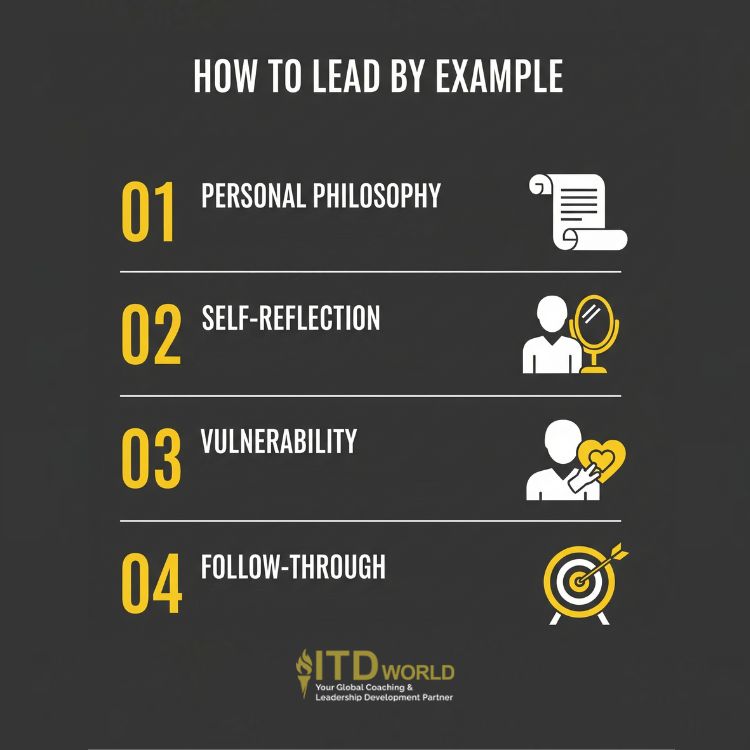Leading by example is the ultimate act of closing the “say-do gap” and earning the trust required to lead effectively.
Great thinkers from across history have all arrived at the same conclusion: being a role model is not just one way to lead – it is the only one that truly matters. In today’s age of transparency and skepticism, a leader’s actions are their only credible message. Leading by example is the disciplined practice of embodying the very standards one wishes to see in their team, thereby turning their values from words on a wall into a lived, daily reality.
|
Author: Jonathan M. Pham |
Highlights
- Leading by example is the practice of embodying the behaviors, work ethic, and values you expect from your team, demonstrating through your actions the standards you wish others to follow.
- Exemplary leadership helps build trust and credibility in a skeptical world, inspires commitment from modern workforces, and directly drives productivity and business results by fostering a culture where teams emulate positive behaviors.
- The style requires unwavering character (integrity, humility, accountability), consistent action (strong work ethic, calm under pressure, openness to feedback), and compassionate connection (empathy, respect) to inspire and guide a team effectively.
- To lead by example, one needs to start by defining their personal leadership philosophy, consistently practice disciplined self-reflection to ensure alignment between their words and actions, be vulnerable enough to admit mistakes, and master the art of follow-through by honoring their commitments. For organizations, they should aim to promote based on character, create a high-feedback environment, amplify positive leadership examples, and invest in targeted training and coaching.
- Leading by example presents challenges such as the desire for perfection, maintaining integrity under pressure, and the exhaustion of constantly being “on” ; these problems can be addressed by modeling authenticity in imperfection, anchoring actions in a strong personal philosophy, and prioritizing sustainable high performance over quick results.
What Does Leading by Example Mean?
Leading by example (also referred to by other names such as “exemplary leadership”, “leadership modeling”, “role model leadership”, “setting the standard/ walking the walk/ showing the way/ practicing what one preaches”, etc.) is the practice of demonstrating the specific behaviors, work ethic, and values that one expects from their team. More than just talking about a set of standards, it means directly embodying them in one’s daily actions.
Leading by example is the very essence of authentic influence. When there is an absolute alignment between your words and deeds, you essentially demonstrate the willingness to hold yourself to the same, if not higher, standard than what is expected from others. This is what gives one the moral authority to lead – which is far more powerful than the formal authority granted by a title alone.
Leading by Decree vs. Leading by Example
At the end of the day, every leader has to make a fundamental choice, whether consciously or not: do they lead primarily through their position or through their actions? The difference between these two approaches is profound – and it is what determines the type of culture and commitment one creates.
| Aspect | Leading by Decree (By Words) |
Leading by Example (By Actions)
|
| Source of Authority | Position and title (“Do it because I’m the boss”). |
Credibility and earned respect.
|
| Team Motivation | Compliance, obligation, fear of consequences. |
Commitment, inspiration, and a shared sense of purpose.
|
| Employee Response | A sense of “I have to do this.” |
A sense of “I want to do this.”
|
Example: One who leads by decree might send out a memo that says, “Our new policy is to respond to all client inquiries within 24 hours.” An exemplary leader, on the other hand, is simply seen by others consistently responding to their own important emails with speed and professionalism. They set the standard through their own visible behavior, inspiring the team to follow suit without needing to issue a formal command.
Read more: Leader vs Boss – 11 Key Differences (Which One Are You?)

Lead by example leadership style
Why is Leading by Example Important?
- Cultivates trust in a skeptical world
In an era of widespread misinformation and low institutional trust, people are generally more skeptical than ever. They place a high premium on authenticity and tend to believe in what they see one does far more than what they hear them say.
According to The Edelman Trust Barometer, employees’ trust in their employer is deeply linked to their perception of their leaders as being credible, reliable, and ethical – qualities that can only be proven through consistent action.
- Inspires commitment from new generations
Modern workforces, particularly Millennials and Gen Z, are less motivated by traditional, hierarchical authority. Rather, many of them are inspired by individuals they personally respect and whose actions are aligned with their stated values. Studies have revealed that those who belong to these generations are quick to call out inauthenticity and are more likely to be loyal to organizations where the management demonstrate integrity and a genuine care for their people.
- Drives productivity & business results
When leaders model a high work ethic, a focus on quality, and a commitment to collaboration, their teams are far more likely to emulate those behaviors. Gallup research has consistently shown a direct link between the engagement of a manager and that of their team, which in turn drives key performance outcomes like productivity and profitability. In other words, an exemplary leader creates an exemplary team.
A Masterclass in Leading by Example: The Haruka Nishimatsu Story
One of the most moving modern examples of this principle in action is Haruka Nishimatsu, the former CEO of Japan Airlines (JAL). When JAL was facing severe financial hardship, Nishimatsu took extraordinary steps to show solidarity with his employees.
He slashed his own salary to a level below that of the company’s pilots, took the public bus to work, and ate his lunch in the employee cafeteria. These were not just cost-cutting measures; they were visible acts of leadership. By personally sharing in the sacrifice, he demonstrated his commitment to the company and its people in a way no speech ever could. His act of leading by example was widely credited with rebuilding employee trust, boosting morale, and fostering the collective will needed to achieve one of the most remarkable turnarounds in corporate history.
Read more: Compassionate Leadership – Beyond Simply ‘Being Nice’
Leading by example to deliver business results
Components of Leading by Example
-
Unwavering CHARACTER
The invisible foundation of a leader’s example – their core identity, values, and moral compass. It is a reflection of who they are, especially when no one is watching.
An exemplary character is built on:
- Integrity & ethics: A non-negotiable commitment to honesty and doing the right thing.
- Humility: The self-awareness to admit mistakes, give credit freely to the team, and remain open to learning from anyone, regardless of their title. It is the quiet confidence that prioritizes the mission over personal ego.
- Accountability: Taking full and personal ownership of outcomes – both good and bad – without blaming others or making excuses.
Read more: Ego in the Workplace – The Hidden ‘Evil’ Behind Team Dysfunctions
-
Consistent ACTION
The visible manifestation of one’s character. It is where their values are translated into observable, daily behaviors that set the standard for the entire team.
- Strong work ethic: Demonstrating the level of diligence, commitment, and quality that they expect from others. An exemplary leader does not ask for an effort they are unwilling to give themselves.
- Calm under pressure: Modeling resilience and composure during a crisis or when faced with a setback. Being able to remain calm and focused on solutions gives others the confidence and psychological safety to navigate the challenge.
- Openness to feedback: Actively seeking out and gracefully receiving constructive criticism. Their action models a growth mindset and reinforces a culture where everyone is accountable for continuous improvement.
-
Compassionate CONNECTION
The crucial human element that makes a leader’s example inspiring, not just intimidating. It’s about how they treat people on the journey and is the key to earning loyalty and discretionary effort.
- Empathy: The genuine effort to know the perspectives and feelings of team members – so as to make decisions that consider the human impact and provide truly helpful support.
- Respect: Treating every individual with dignity, regardless of their role or status. It is demonstrated in seemingly trivial but critical ways every day, such as listening attentively in meetings, valuing everyone’s input, and communicating with professionalism and kindness.
When one aligns their Character, Actions, and Connections, they model a powerful and authentic example that secures trust and motivates people to follow not out of obligation, but out of respect.
Read more: Human Leadership in a Digital World – Skills & Strategies for Sustainable Success

Exemplary leadership skills & qualities
How To Lead by Example: Best Practices for Becoming a Role Model
-
Start with a personal philosophy
You cannot consistently model your values if you have not first taken the time to define what they are. The first step is to articulate what you stand for – by taking the time to come up with a personal leadership philosophy. Ask yourself:
- What are my core values?
- How do I believe people should be treated?
- What is the standard of excellence I am committed to?
- etc.
Having this personal “charter” provides you with a clear standard against which you can measure your own actions.
-
Practice disciplined self-reflection
This is the essential private work of ensuring one’s actions remain aligned with the defined example. It is the internal accountability check that precedes all public credibility.
At the end of each day or week, try to schedule a brief, non-negotiable appointment with yourself. Reflect on one simple but deep question: “Did my actions today reflect the leader I want to be?”
This regular practice of self-assessment should allow you to catch any “say-do” gaps before they become credibility problems for the team.
-
Embrace vulnerability
One of the best ways to lead by example is to model how to handle imperfection courageously.
When you make a mistake, just admit it openly and apologize.
When you don’t have the answer to a question, be honest and say, “I don’t know, but I will find out.”
Such willingness to show vulnerability doesn’t undermine your authority; rather, it contributes significantly to fostering deep, authentic trust and creating a psychologically safe environment where team members feel comfortable being human, too.
-
Master the art of follow-through
A leader’s credibility is built on a foundation of reliability. Leading by example means that your word is your bond, and your commitments are always honored. Put it simply, you need to do what you say you are going to do.
If you promise to review a report by Friday, review it by Friday.
If you commit to providing a resource for your team, follow up and ensure they have it.
Every kept promise, no matter how small, reinforces your example of accountability and integrity.
Read more: 12 Golden Leadership Principles for Attaining Excellence

How to walk the talk as a leader
Establishing a Culture of Exemplary Leadership in the Workplace
- Promote based on character, not just charisma
The most powerful signal an organization sends about its values is reflected in who it chooses to promote. To cultivate a culture of exemplary leadership, the process must prioritize substance over style and integrity over image.
Example: Move beyond just asking about a candidate’s achievements. Use behavioral interview questions like, “Tell me about a time your actions were out of sync with your stated values. How did you handle it, and what did you learn?” This helps identify those who possess the self-awareness and ethics to lead by example.
- Create a high-feedback environment
Leaders cannot be a good role model if they have significant blind spots about their own behavior. Hence, the organization must provide safe and structured systems for them to receive honest input.
One of the most effective tools for this purpose is the 360-degree feedback process. By providing confidential, multi-source input on how one’s actions are perceived by their managers, peers, and teams, you give them the objective data they need to ensure what they do is having the intended positive impact.
- Amplify the right examples
The principle “what gets celebrated gets repeated” is the cornerstone of culture-building. Specifically, the company must be intentional about the stories it tells and the leaders it holds up as role models.
Example: Instead of only celebrating those who closed the biggest deal, use your internal communications channels to spread the message about a leader who made a difficult ethical choice that upheld the company’s values.
- Invest in leadership development
The qualities of an exemplary leader – such as self-awareness, humility, and the courage to be vulnerable – are sophisticated skills that can be systematically developed through targeted training and coaching. For those in management positions, one-on-one coaching provides a confidential space for them to explore their own “say-do” gaps and commit to closing them.
Challenges of Leading by Example
The path of an exemplary leader is not without its own pressures and pitfalls. In fact, even the most well-intentioned individuals may still struggle to “walk the talk” every single day.
- The desire to be perfect
Once a leader commits to setting the standard, it is easy for them to feel an immense pressure to be flawless. They may fear that one small, human mistake – like losing their patience in a stressful meeting or missing a self-imposed deadline – will be seen as hypocrisy and completely invalidate their credibility.
Solution: Model how to handle imperfection. The goal is not to be perfect, but to be authentic and accountable. Your response to a misstep is typically a much more impactful example than never making one at all.
Example: If you fail to live up to your own standard, address it directly. You could say to your team, “I want to apologize for my tone in that last discussion. I was frustrated, and I did not handle that constructively. That is not the example I want to set.”
- Maintaining integrity under pressure
It is simple to live by one’s values when things are going well. The true test, however, comes when you are under intense pressure to hit a short-term target, and you are tempted to cut a corner or bend a rule, especially when you think no one is watching.
Solution: Anchor your actions in a deeply rooted personal philosophy. Your motivation to lead by example must be intrinsic, not based on a desire for external validation. In other words, you need to strive to make the right choice not because you might get caught, but because your own integrity demands it.
- The exhaustion of being “on” 24/7
The emotional labor required to consistently model composure, empathy, and a strong work ethic can be incredibly draining. For many, they may suffer from a form of “role fatigue” that can lead to burnout.
Solution: Model sustainability, not just strength. Leading by example does not mean being the first to arrive and the last to leave every single day – that only sets an unsustainable and unhealthy standard for the team. A truly exemplary leader is one who demonstrates a sustainable approach to high performance.
Example: Visibly taking your vacation time to fully disconnect, protecting your weekends for rest and recovery, and encouraging the team to do the same. Doing so makes it clear that the organization values long-term well-being over short-term burnout.

Role modeling in leadership
Lead by Example Quotes
Check out more leadership quotes here!
The three most important ways to lead people are: by example, by example, by example.
Albert Schweitzer
Leading by example is the ultimate test of leadership.
Always do right. This will gratify some people and astonish the rest.
Mark Twain
Be the change you want to see in the world.
Mahatma Gandhi
What you are speaks so loudly, I can’t hear what you are saying.
Ralph Waldo Emerson
If your actions inspire others to dream more, learn more, do more and become more, you are a leader.
John Quincy Adams
The most powerful leadership tool you have is your own example.
John Wooden
People may teach what they know, but they reproduce what they are.
One of the most important actions, things a leader can do, is to lead by example. If you want everyone else to be passionate, committed, dedicated, and motivated, you go first!
Setting an example is not the main means of influencing others, it is the only means.
Albert Einstein
Lead by example, not by force.
Sun Tzu
Do nothing out of selfish ambition or vain conceit. Rather, in humility value others above yourselves, not looking to your own interests but each of you to the interests of the others.
Books about Leading by Example
- 📘 Lead by Example: 50 Ways Great Leaders Inspire Results by John Baldoni
A practical guide packed with 50 bite-sized lessons on leadership. In his work, Baldoni emphasizes trust, integrity, and everyday actions that contribute to credibility. It’s an ideal read for managers looking to motivate teams through consistent behavior and clear values.
- 📗 Leadership by Example by Dr. Sanjiv Chopra
Based on a globally acclaimed lecture, the book outlines ten core principles of effective leadership. Chopra blends historical anecdotes with personal stories to demonstrate how anyone can lead in their own sphere by embodying traits like humility, empathy, and courage.

How ITD World Can Help
At ITD World, we specialize in enabling leaders to close the “say-do gap” and acquire the credibility required to lead effectively. Our programs are designed to cultivate the core pillars of an exemplary leader – and to support organizations in establishing a culture where this is the expected standard.
- To Build Unwavering CHARACTER: Our executive coaching service and workshops on values-based leadership provide a confidential and thought-provoking space for leaders to foster the self-awareness, humility, and integrity that form the foundation of their personal example.
- To Develop Consistent ACTION: ITD World’s programs focused on leadership resilience and giving effective feedback are designed to equip participants with the practical knowledge to act with composure under pressure – and to model a growth mindset for others.
- To Foster Compassionate CONNECTION: We offer targeted workshops on emotional intelligence and interpersonal communication that enable one to build the empathy and respect needed to connect genuinely with people and inspire deep, lasting trust.
Additionally, we also partner with organizations to deliver customized in-house solutions that help align your leadership development and promotion systems to identify, cultivate, and reward those who truly “walk the talk.”
Ready to become the kind of leader others are willing to follow? Contact ITD World today to learn how our solutions can help!
Other resources you might be interested in:
- Servant Leadership: A Transformative Management Philosophy
- Transformational Leadership: Inspiring Change & Growth
- Love Leadership: More Than an Abstract Philosophical Idea
- Spiritual Leadership: A Remedy for Today’s Workplace Woes
- Visibility at Work: Key to Sustainable Career Advancement

